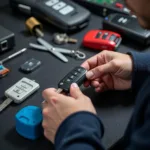Leather car seats instantly elevate the luxury and comfort of your vehicle’s interior. However, over time, wear and tear can take a toll, leading to cracks, fading, and other unsightly damage. Fortunately, repairing leather car seats is often possible, restoring their pristine appearance and preserving their value.
Understanding Leather Car Seat Damage
Before delving into repair options, it’s crucial to understand the common types of damage that can occur to leather car seats:
- Cracks: These are perhaps the most common issue, often caused by age, dryness, and repeated flexing of the leather.
- Scratches: Sharp objects, pets, or even rough clothing can leave unsightly scratches on leather surfaces.
- Fading: Prolonged exposure to sunlight can cause the leather’s color to fade, resulting in a dull and uneven appearance.
- Stains: Spills from food, drinks, or other substances can easily stain leather seats if not cleaned promptly.
- Wear and Tear: Frequent use, especially in high-traffic areas, can lead to general wear and tear, resulting in thinning, smoothing, or discoloration.
DIY vs. Professional Repair: Which Route to Take?
When it comes to repairing leather car seats, you have two primary options: do-it-yourself (DIY) or hire a professional. The best approach depends on the severity of the damage and your comfort level with car upholstery repair.
DIY Repair:
DIY repair is suitable for minor damage like surface scratches, light fading, or small cracks. Numerous leather repair kits are available online and at auto parts stores, offering a cost-effective solution for minor imperfections. These kits typically include cleaning solutions, fillers, dyes, and tools to address specific types of damage. However, it’s crucial to follow the instructions carefully and test the products on a hidden area first to ensure color matching and prevent further damage.
Professional Repair:
For extensive damage like deep cracks, tears, or significant fading, seeking professional help is highly recommended. Professional auto upholsterers possess the expertise, tools, and materials to address complex repairs effectively. They can repair tears seamlessly, re-dye faded leather, and restore your seats to their former glory. While professional repair comes at a higher cost, it ensures a high-quality and long-lasting solution, preserving the value of your vehicle’s interior.
Can You Repair Leather Car Seats with Cracks?
Cracks are a common sight on older leather car seats, often appearing as thin lines or deep crevices. While frustrating, cracks can often be repaired, preventing further damage and restoring the seat’s appearance.
For minor cracks, DIY leather repair kits can be effective. These kits usually contain a filler that can be applied to the crack, followed by a color-matching dye to blend the repair seamlessly. For deeper cracks, professional intervention might be necessary. Professionals can use specialized techniques like leather stitching or patching to address extensive damage effectively.
To learn more about repairing cracks in your car seats, check out our dedicated guide: how to repair leather car seats with cracks.
Factors Affecting Repair Costs
The cost of repairing leather car seats can vary significantly depending on several factors:
- Extent of Damage: Minor scratches are less expensive to fix than deep cracks or tears.
- Type of Repair: DIY repairs using kits are generally cheaper than professional services.
- Leather Type and Quality: Premium leather types might require specialized care and materials, affecting the overall cost.
- Location: Labor costs can vary depending on your geographical location.
To get a better understanding of potential repair expenses, you can consult our comprehensive guide on: how much is it to repair leather car seats.
Preventing Future Damage
While repairs can effectively address existing damage, prevention is always better than cure. Here are some valuable tips to protect your leather car seats and keep them looking their best:
- Regular Cleaning: Clean your seats regularly using a leather cleaner and a soft microfiber cloth.
- Conditioning: Leather conditioners help keep the material supple and prevent drying and cracking.
- UV Protection: Park your car in the shade or use a windshield sunshade to minimize sun damage.
- Avoid Sharp Objects: Be mindful of sharp objects that can scratch the leather.
- Prompt Spill Cleanup: Address spills immediately to prevent staining.
Conclusion
Repairing leather car seats is an investment that can restore their beauty, extend their lifespan, and maintain your vehicle’s resale value. By understanding the causes of damage, exploring repair options, and adopting preventive measures, you can keep your leather car seats looking pristine for years to come. If you’re ever unsure about the best course of action, don’t hesitate to consult with a professional auto upholsterer for expert advice tailored to your specific needs.


